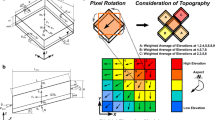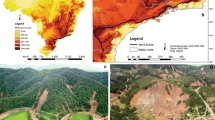Abstract
A model for the analysis of topographic influence on shallow landslide initiation is applied to an experimental mountain basin where high-resolution digital elevation data are available: the Cordon catchment (5 km2) located in northern Italy. The model delineates those areas most prone to shallow landsliding due to surface topographic effects on hydrologic response. The model is composed of two parts: a steady-state model for shallow sub-surface runoff and an infinite-slope Coulomb failure model which assumes that the soil is cohesionless at failure. An inventory of landslide scars is used to document sites of instability and to provide a test of model performance by comparing observed landslide locations with model predictions. The model reproduces the observed distribution of landslide locations in a consistent way, although spatial variations in soil strength and transmissivity, which are not accounted for in the model, influence specific distribution of landslide areas within regions of similar topographic control.
Similar content being viewed by others
Author information
Authors and Affiliations
Additional information
Received: 15 October 1996 · Accepted: 25 June 1997
Rights and permissions
About this article
Cite this article
Borga, M., Dalla Fontana, G., Da Ros, D. et al. Shallow landslide hazard assessment using a physically based model and digital elevation data. Environmental Geology 35, 81–88 (1998). https://doi.org/10.1007/s002540050295
Issue Date:
DOI: https://doi.org/10.1007/s002540050295




